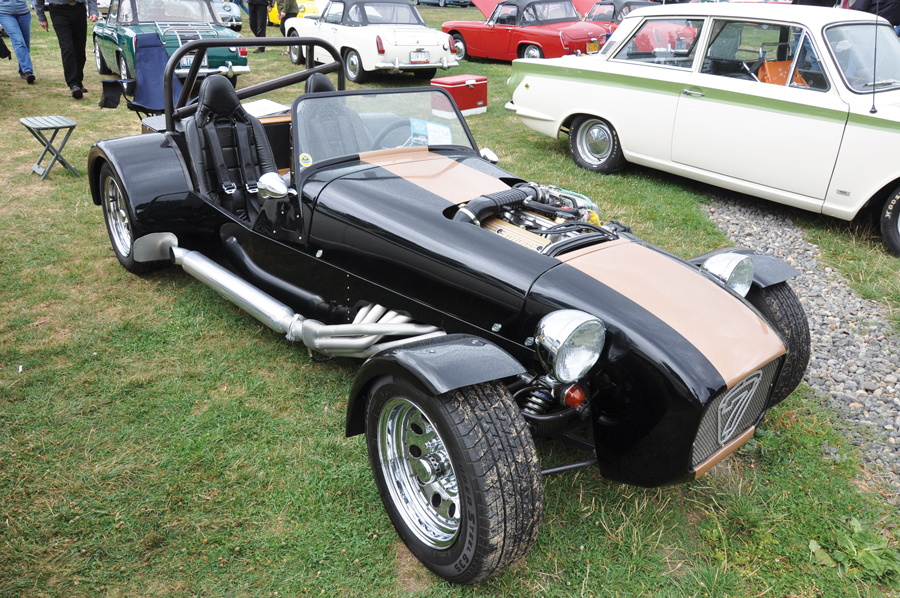In 1958, Lotus Cars founder Colin Chapman came up with a design for a basic sports car that could be road-driven all week and then raced on the weekend. His previous (and very similar) design was called the Lotus Mark VI, so this new model was naturally called the Seven. Chapman wasn’t overly impressed with his work, remarking, “There wasn’t much to it, really. It was all well-known stuff, the sort of thing you could dash off in a weekend.”
What is a Lotus Seven?
The Lotus Seven is based on a tubular space-frame design, similar to other sports-racer designs of the same period. The design anticipates that the engine will go in front of the driver longitudinally, with the transmission and driveshaft in the center of the car, heading back to a solid rear axle or De Dion rear suspension. Viewed from above, the Seven’s chassis is wedge-shaped, providing side-by-side seating for driver and passenger just ahead of the rear axle.
As was typical for Lotus, a variety of engine and driveline components were used in the Seven.
Production started with a 1.2-liter Ford flathead 4-cylinder at 28 horsepower, but quickly moved up to a 75-horsepower Coventry Climax or the 948-cc and 1098-cc BMC A-series, followed by the 1.5-liter Ford Kent powerplant and then a variety of better engines. As early as 1958, Sevens equipped with the Coventry Climax engine were called Super Sevens.
The sincerest form of flattery
According to the Historic Lotus Register, the Lotus factory produced just 2,557 Sevens in four series between 1958 and the end of Lotus factory production in 1973. But that’s just the beginning. In 1973, Lotus sold the rights to produce the Seven to Caterham, a British specialty car company that has produced the Seven continuously since that time.
The modern Caterham Seven shares no parts with the original Lotus Seven, and while it looks mostly the same, modern engines and suspension designs have lifted the performance and reliability of the car far beyond anything Lotus Cars could have achieved in their day. A new 2020 Caterham Seven starts at $37,900 and tops out at about $65,900, depending on what you want. The top-priced Caterham will hit 60 mph in about three seconds, or just a little shy of a modern exotic.
You can get your hands on a quality Caterham Seven made at some point in the past 47 years for about $20,000 if you hunt around a bit. Original Lotus Sevens generally trade a little higher (SCM# 6912305) but aren’t often seen at auctions.
But even that’s not the biggest part of the story.
Chapman wasn’t being falsely modest when he described the Seven as something you can build in a weekend. Well, maybe a weekend if you have a full racing fabrication shop, but let’s say a few weeks for an amateur with reasonable skills. That fact has led more than 160 different companies to produce various finished cars, kit cars, and plans copying the Seven to some degree or another. In fact, the Lotus Seven is easily the most copied vehicle design in history. Sorry, Cobra fans, it’s not even close.
Build Your Own Seven
If you’re confident in your skills, it’s still possible to buy a set of plans and a pile of metal and build your own version of the Seven called a Locost. Haynes has a good book called Build Your Own Sports Car For As Little As £250 — And Race It! that contains plans, parts lists, and all the advice you might need to build your own Seven.
If that sounds like fun, go ahead and check out sites like Sevenesque.com and cheapsportscar.net for free plan downloads, and visit LocostUSA.com to join the enthusiast community.
If you want to strike the middle ground, Caterham will sell you a knock-down kit with pre-assembled components. The wiring harness is installed in the chassis, for example, saving the average DIYer about a year of frustration and at least one ruined marriage. This is a great choice for the realistic hobbyist.
Buying a Seven
The big clue about buying a Seven is realizing that each one is an individual. With 62 years of production and hundreds of companies eagerly making their own changes, finding two Sevens that are exactly alike is a challenge.
If you want to make a good decision about buying a Seven, you have to stick to the fundamentals, and then some. Don’t just check for rust and corrosion — look at the quality of welds on the space frame. Is the frame straight now? Was it ever straight? What engine did the builder choose, and how are the engine and driveline installed? Is the wiring harness a nightmare of butt connectors and loose ends? You get the idea.
Most buyers should expect to spend about $20,000 for a well-sorted Seven. I’m not saying there aren’t bargains out there, but cheap Sevens are usually priced that way for a reason.
The bottom line is this: Never in the history of buying old cars is a competent pre-purchase inspection more important than when considering some flavor of the Lotus Seven. Find a shop that knows what they’re looking at and pay them to tell you the rugged truth. The reward for your efforts is that when you find the right one, you’ll enjoy a top-performing sports car that will never go out of style. ♦
A Fun Copycat

